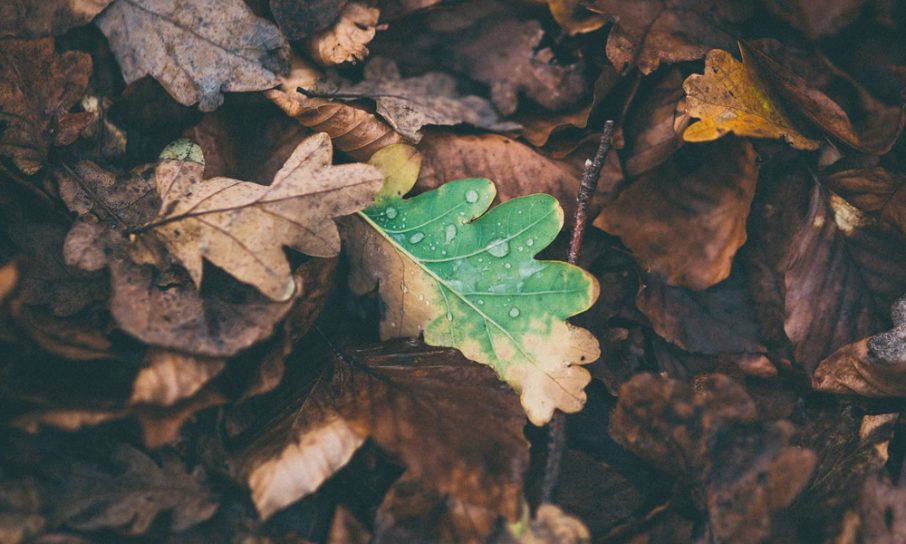There are many different tree diseases to watch for in Wisconsin. Over the coming months we will look at a few of them and review ways to treat and prevent them. The first of these diseases is one called Oak Wilt.
Oak wilt is an exotic tree disease that is devastating to almost any Oak infected. It spreads quickly and can kill a tree in a single season. Once the tree is infected it cannot be saved and will spread the disease to surrounding oaks if not promptly removed. In this post we will examine the history of the disease, symptoms, and remediation options for the disease.
History and Spread of Oak Wilt Disease
Oak Wilt is one of three devastating tree diseases that have infected North American forests since the beginning of the 1900’s. The origin of the disease is unknown. It was first observed in the Upper Midwest, but there are theories that it may have moved into the United States from Mexico or further South. It is probable that the encouragement of oak varieties as the predominant forest wood due to deforestation of the coniferous forest and fire suppression as the population of the Midwest grew led to the spread of the disease.
Since it was first described in a tree in Wisconsin, this rapidly spreading disease has been reported throughout the Midwest and Texas. While it is currently only a threat to most varieties of oak in North America, its persistence and the lack of resistance to its effects in oak trees means that it is a serious threat to oak varieties worldwide.
Oak Wilt is spread to trees in several ways. While the spores can travel as airborne particulates, the primary transmission of the spores is through insects, small animals, and birds. As the spores are picked up on their bodies, they transfer said spores to uninfected trees. The spores do not infect the tree unless they are introduced through a broken or pruned branch or some other wound on the tree. Once introduced, the infection spreads rapidly and can kill the tree within six weeks.
Death is primarily caused by a combination of the function of the spores and the tree’s own reaction to the infection. The fungal spores multiply to the extent that they clog the vascular system of the plant. In reaction to the infection, the tree’s defense mechanisms dramatically increase the production of gums and tylose formations. These are created in an attempt to compartmentalize the infection, but ultimately they inhibit the flow of water and nutrients. The two processes combine and lead to the collapse of the vascular system causing the death of the tree.
In addition to spreading by insects and other vectors, the disease is also transmitted to other oak trees through root grafts. Oak trees have extensive root systems. These root systems often intersect. Through a process known as inosculation, the roots of oak trees will often graft together as special cells in their roots are pressed together and combine. Due to this process trees in proximity to each other can share nutrients and information. Making use of this interconnected vascular system, the spores of the oak wilt fungus will travel to other trees allowing the infection to kill many trees in a single infection. The root network of an infected group can harbor and transmit the infection for years.
Symptoms of Oak Wilt Tree Disease
The initial symptom of an Oak Wilt fungus infection is the wilting, browning, and dropping of the leaves of the tree in early to late summer. This process will occur from the top of the tree to the base, beginning with the defoliation of the crown of the tree. Unlike normal leaf fall, these leaves will still be partially green. Infected leaves will appear to be dull green to bronze in color and will often appear to be water-soaked if still dark green. This initial symptom is similar to other tree diseases that affect oak trees, so you will want to look for secondary signs of the infection.
As the disease progresses the tree will experience dieback beginning with the crown and spreading downward. In red oak trees, the infection culminates in a fungal mat that forms under the bark of the tree. The mat is elliptical in shape and white in color, darkening with age creating a somewhat bullseye effect. The mat spreads and grows under the bark eventually creating pressure that bulges the bark until it splits. This crack will emit a very distinctive odor sometimes described as smelling like fermenting fruit. This final stage only occurs in red oak trees.
Varied Symptoms For Oak Types
While the symptoms for oak wilt are generally similar, each major variety of oak has its own set of peculiarities:
- RED OAK: Red oak trees are the most vulnerable to oak wilt.
- The symptoms of this tree disease are less conspicuous at first. For instance, while the leaves will turn brown they do not drop but rather remain connected. This results in a symptom referred to as flagging where the tree will resemble its normal autumn appearance in the middle of summer.
- Red oak trees are not only more likely of any to develop this infection, they die the most quickly of any of the varieties of oak. The process from infection to death is normally 6-8 weeks.
- Red oaks are also more likely to create root grafts with other oak trees, allowing the disease to spread more easily to other oak trees in the stand.
- Red oak trees never survive an infection of oak wilt.
- LIVE (EVERGREEN) OAK: This variety of oak is able to withstand the infection longer, but will eventually succumb to the disease.
- Most live (or evergreen) oak trees will defoliate and die within 3-6 months of the initial infection.
- It is possible for a live oak to remain in various stages of decline over many years before finally succumbing to the disease.
- There have also been examples of live oaks surviving the decimation of a stand of oak trees without becoming infected.
- A symptom that is unique to the live oak is referred to as “veinal necrosis”, where the veins of its leaves turn yellow and then brown. The remainder of the leaf begins to turn as the brown spreads from the vein. Sometimes the vein of the leaf will appear to turn a deeper green than the rest of the leaf in a process called “vein banding”. Tip burn (sometimes called margin burn) which turns the edges of the leaf brown can also be observed.
- WHITE OAK: White oaks are the most robust of the oak species in relation to oak wilt.
- Most white oak trees exhibit at least some canopy loss from this tree disease.
- White oaks are least likely to spread the infection as they are not able to support the development of the fungal mat and are less likely to develop root networks through grafting.
- The progression of the effects of the infection will occur from the crown downwards, but will often be isolated to one branch or occur irregularly through the tree. This variety of oak is more likely than the others to ultimately survive the infection, although they will lose some branches to it.
It is important to note that oak wilt is a devastating and virulent tree infection. Although white oak trees are more likely to survive this infection, that is a relative statement. Many white oaks die from oak wilt and some of them die quickly. Also, just because this variety is less likely to spread the infection does not mean that they will not.
Remediation of Oak Wilt
Unlike some other tree diseases, there is no cure for oak wilt that has more than a limited chance of success. In most cases, the tree will die. In some cases, the tree will be dramatically impacted. In rare cases, the tree will survive without contracting the infection while the entire stand around them dies. The best course of action in most cases is to remove the infected tree, preferably during the winter months in order to significantly reduce the possibility of spread to surrounding trees.
If you have a tree infected by oak wilt you can attempt to reduce the possibility of spread through root grafts by trenching around the tree. This is not guaranteed to stop the spread through the roots, as the root grafting may be deeper than your trench. Normally a trench of four feet in depth that completely surrounds the infected tree is recommended. Additionally, the trenching should be done as quickly as possible after the initial symptoms of the infection are seen, as there is a delay in the initial infection and the display of symptoms.
Fungicidal treatment has some limited success in treating the tree disease in the early stages for certain varieties of oak. It does not stop root transmission, so it should be done in conjunction with trenching. In most cases, fungicide injections will be ineffective for trees already exhibiting symptoms of the disease. However, it can be effective to prevent the spread of the infection to and in non-symptomatic trees.
Prevention of Oak Wilt Tree Disease
As the old saying goes, an ounce of prevention is worth a pound of cure. The following are steps for preventing this devastating tree disease.
- Do not prune oak trees between the months of April – August unless absolutely necessary. If you prune an oak during this period use pruning paint immediately after the cut. Sap-feeding beetles can find these cuts within a half-hour and can transmit the spores immediately.
- Prune broken branches on oak trees as soon as possible, treating the cut immediately with fungicide and pruning paint.
- Sterilize all pruning equipment between trees.
- Diversify your trees as much as possible to prevent a single disease from killing all of the trees on your property. Additionally, plant trees that are native to your area in order to not introduce exotic diseases. This will also provide a sustainable habitat for local birds and wildlife.
- If you have an oak tree that is considered to be high-value, you should treat the oak tree with fungicide by a certified arborist.
- If you have a tree that is infected by oak wilt you will need to do the following:
- Trench around the infected tree(s) at a depth of around four feet and creating a perimeter of 50-100′ beyond the location of the infected tree(s).
- Remove tree between October and March. If you will not be able to remove the tree then girdle it a few inches above the ground and then remove all the bark on the trunk of the tree during the winter.
- You should chip the tree and remove it from the area. If you aren’t able to chip it, then cut it up and burn it. You can save the wood for firewood later if you properly stack it for drying after October and cover it with 4-6 mil clear plastic before March. The plastic will need to be securely sealed to the ground to prevent beetles from getting to the spore mats.
Call Us Today!
As with all tree diseases, it is best to call a certified arborist as soon as possible when you see symptoms. The sooner the certified tree expert is able to evaluate the situation and formulate a course of action the less damage that will be caused. M&M Tree Care is proud to note that all of our managers, sales representatives, and crew leaders are ISA certified arborists. Contact us today with any questions or for a free estimate!

